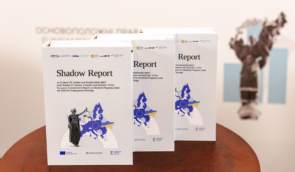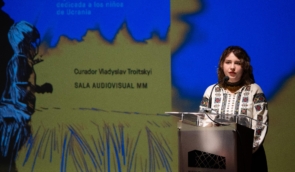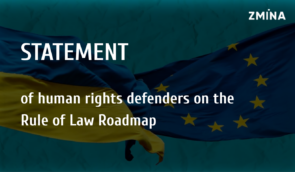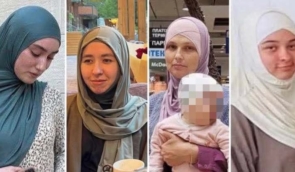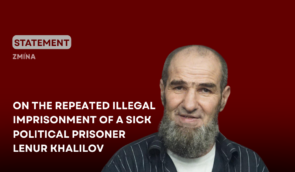Ukraine: Documenting torture despite mines, blackouts, and pervasive fear
Following the full-scale Russian invasion of Ukraine, OMCT’s partner Human Rights Centre ZMINA has been documenting and advocating on torture, enforced disappearances, and extrajudicial killings as a part of the “Ukraine 5 AM Coalition“. Elizaveta Sokurenko, a representative of ZMINA (which means “change” in Ukrainian), tells us about mines, blackouts, difficulties finding victims on the ground, and other challenges faced by her team during field missions to document torture.
 ZMINA human rights experts returning from their most recent field mission, with a rescued puppy
ZMINA human rights experts returning from their most recent field mission, with a rescued puppyWhat is the focus of your fieldwork?
We started our field missions to document torture in September 2022, with visits to the liberated settlements of the Kharkiv and Kherson regions. Our team goes to settlements where Russian troops had set up “torture chambers”. Our colleagues in the Kyiv office collect information from open sources about the places and people who were tortured; then, our field team interviews them in detail on location.
What challenges do you encounter, and how do you deal with them?
The biggest challenge is finding torture victims on the ground, as people travel quite frequently, including to look for medical help. Sometimes, you must look for survivors knowing only the general area where they live but no precise address. It’s easier in small villages because everyone knows everyone else.
Torture survivors are usually willing to talk about their experiences. In some places, however, they prefer to avoid public coverage. We faced this in the Kharkiv region, as people feared the Russian military would come back. In such cases, we guarantee people anonymity.
At the same time, some victims have serious psychological problems. Needs far outweigh opportunities to help, and human rights organisations have minimal resources. We are currently looking for ways to cover material, medical and psychological assistance to torture victims. But we definitely need more help.
Another difficulty is that, with destroyed roads and bridges, it takes a lot of time to get anywhere. For example, we ran over a mine fragment and blew out a wheel during our last mission to Snihurivka, Kharkiv region. Luckily, the State Emergencies Service helped us repair the damage, and we could continue our mission.
Regarding security, I can say that we have the necessary protective equipment and have attended a training on emergency medical assistance during a military operation, mine and explosive safety. In a hospital in the town of Balakliya, Kharkiv region, we came across an explosive device that was sticking out of a decorative flower bucket sprinkled with New Year’s decorations. Russian troops had been based in this hospital. In the village of Husarivka, Kharkiv region, we found anti-vehicle mines stacked in one of the houses. There were also leftover booby traps in the village.
We had to interrupt our latest mission, on 23 November, as Russian shelling caused a blackout, and we couldn’t use cards to pay for petrol. We didn’t have enough cash…
What do your field missions usually look like?
Our last field mission was to the town of Snihurivka in the Mykolaiv region.
The Russian military had set up a torture chamber in the building that used to house the Ukrainian police department. People were kept in cells in the basement. The building is half destroyed, and the rubble has not yet been removed.
We collected the testimony of two men who were held in this basement. One of them was arbitrarily detained twice, interrogated and beaten because his son had organised a self-defence unit in the town. Another one was tortured with electric shocks because he had complained about Russian soldiers robbing his office. We couldn’t talk with two other potential victims because they were not home.
According to the victims and witnesses we interviewed, hundreds of people were held in this torture cellar at different times. Our witnesses constantly heard shouting, and people being dragged down the corridor after interrogation. Two other sources also told us that a veteran, who participated in military operations in eastern Ukraine, was held for ten days, beaten and raped with a spade handle by the Russian troops. He managed to get out of town.
We are waiting for additional information and will return to Snihurivka.
During this mission, we also picked up a puppy on the road.
How do you plan to use the testimonies that you are documenting?
We enter the mission protocols into the joint database “Ukraine. 5am”, a coalition of Ukrainian human rights organisations. We then pass the information to Ukrainian law-enforcement agencies and will also prepare a submission to the relevant international mechanisms. We have already submitted documentation from a field mission to the Kharkiv region to the UN Independent International Commission of Inquiry on Ukraine. After that, the Commission experts visited Balakliya to meet with the people we had interviewed. We also publish some of the stories on our website.
Documenting torture during an active armed conflict sounds complex and dangerous. What could make it easier?
This is a difficult question. We are currently developing the area of documenting war crimes and crimes against humanity and learning a lot in the process. Our field coordinator has eight years of experience in this sort of fieldwork. We would benefit from having another person with similar experience on our team.
A unified system of access to liberated settlements would also help since there are sometimes problems at checkpoints.
The Human Rights Centre ZMINA works to protect freedom of speech, assembly and associations, freedom of movement, combating discrimination, preventing torture and ill-treatment, and protecting human rights defenders and civic activists in Ukraine, including in Russia-occupied Crimea. From 2012-2018, ZMINA was engaged in launching and developing the National Preventive Mechanism (NPM) in Ukraine. This independent body was set up and is currently operating under the Optional Protocol to the UN Convention against Torture, aimed at regularly monitoring detention places to prevent prisoners’ ill-treatment. In particular, the organisation actively participated in the campaign on the inadmissibility of torture and ill-treatment in places of detention; the development of strategic and operational plans of the NPM; the mechanisms for monitoring visits, selection, training and motivation of monitor; the development and self-organisation of community monitor, creating online maps of the places of detention and their status based on the results of the visits; as well as conducting visits to custodial settings.
Source: SOS-Torture Network
If you have found a spelling error, please, notify us by selecting that text and pressing Ctrl+Enter.



